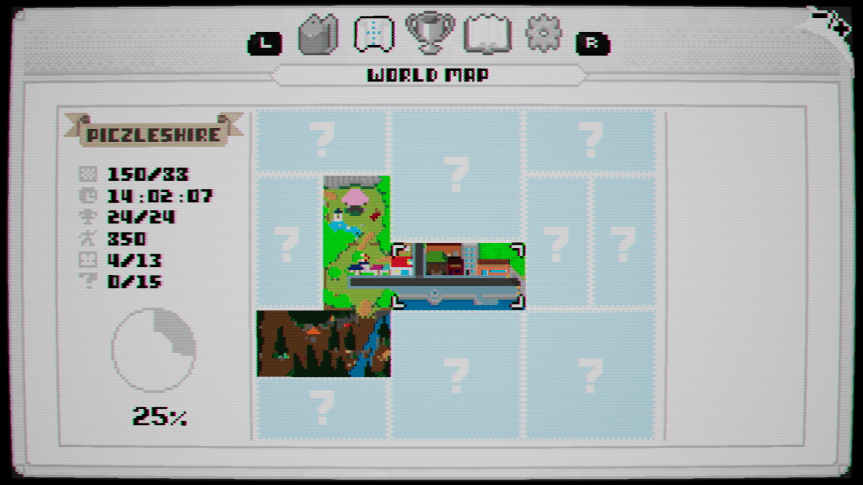Designing for short and long term fun
A simple design roadmap to ensure long-term enjoyment in Piczle Cross Adventures.

(This is a repost from the Piczle Cross Adventure devblog at blog.piczle.club)
From the very first game the Piczle series has been about adding some game-y-ness to the logic-puzzle formula. Even though most logic-puzzles in and of themselves appeal to puzzle fanatics, I truly believe that adding an extra layer or two on top of them can enhance the experience.
The problem with a lot of game design ideas is that they are fairly obvious or at least sound very obvious when written down. In this post I’ll try to explain a system I keep in mind when I design my games.

The Multi-level (it’s not a pyramid!) experiential graph
As a mental road-map I often make myself refer to a thing, which I’ve never named, but let’s say the “Multi-level (it’s not a pyramid!) experiential graph” (like one half of the conjoined triangles of success). Every element of the game design falls within one of these bands. During development I try to compartmentalise design decisions within these bands and, more importantly, try to make sure the game has all of these bands, the bottom one being the most important.
Immediate
Immediate experience are things like control, and the very basic task of your game. What is the player actually doing the most, from minute to minute? Obviously in Piczle that refers to the actual logic-puzzle element. Do the controls feel right? When the player presses action is the result immediate and satisfying?

E.g. in Piczle Lines DX I added little touches like the completed line animating, albeit very quickly, to fill out. Or when you deleted a line it would pop into a small shower of pixels. In Piczle Cross Adventureblocks and crosses animate in. When you move the cursor there is an subtle rumble (which can be switched off) and if you have selected the “auto-correct” option, when you draw a block incorrectly the screen shakes, the block flashes red. A lot of time has been spent to make this element of the game feel satisfactory. Afterall, this is what you spend most of the time doing.
Immediate 2
In Piczle Cross Adventures there is actually a second immediate experience and that is character control. As you move your main character, Score-chan, around the world it has to feel satisfactory. Tweaking movement speed continues as the project progresses. Dust clouds appear as she runs. She is the only character in the game to be animated with 8 directions of movement (everybody else, to save time, only moves up, down, left or right, but Score-chan can move up and left or down and right and all the other combinations as well). Score-chan has double the number of frames of animation compared to NPCs (non-player characters) as well. Her head-bob as she walks is more pronounced. She also has a host of idle animations.

Exploring with Score-chan and Gig
If I am to invite players to invest their time into exploring the world, finding secrets and puzzles it needs to control well and be fun.
Short-term
The short-term experience is the fun of completing a puzzle, seeing the solution, seeing the object become part of the world and seeing how well you did. Puzzle clearing itself is an addictive built-in element of logic-puzzles. Even so there is still some design that comes into play. How can I ramp up the challenge and size of the puzzles without hampering the fun of clearing puzzles too much. It’s no fun to have 2 or 3 easy puzzles and then be stuck with an endless series of puzzles that each take too long to clear. Similarly you don’t want too many small and easy puzzles in a row.

So many puzzles dotted around the world
In Piczle Cross Adventures it’s a lot harder to design this progression because to an extent the player can choose which puzzles to play in whatever order they come across them. There will be some designed roadblocks that will steer the player in certain ways, or rather blocks them from progressing in certain areas too early, but generally it’s fairly free flowing. As such I’m trying to mix it up a little. There will be a steady progression of puzzles in size and complexity but at every point on the map you can still find easier puzzles, as little palette cleansers. It won’t be until the late game that players will be tackling mostly larger complex puzzles. Until that time it is important for the player to feel the pleasure of clearing a puzzle at decent intervals.
Intermediate
As the player is experiencing all these immediate and short term game mechanics, and hopefully enjoying themselves, there are some intermediate goals to keep the player engaged.
Most obvious will be the story progression. The player will find and open up new areas, which act as puzzle themes. Some new skills are learned (or rather objects are found), fairly early on, that help with your adventuring. Some simple world puzzles will lead to new map areas. New characters are found and can be conversed with, all while you find out more about the story’s arc and eventually its final denouement.
It is important that NPC interaction is fun or useful. There won’t be extensive dialogue trees, just throwaway comments or plot exposition when you chat with NPCs. The throwaway dialogues should all help solidify the characters, their motivations and personalities, as well as throw in a few jokes here and there. Players of Piczle Colors may have noticed Score-chan’s propensity for lame puns. Expect some groaners in Piczle Cross Adventure as well!

The trophies/achievements screen
Part of the intermediate experience also lies in earning trophies. As the player progresses they can earn trophies for reaching certain milestones. Most of these will be automatic (clear an X number of puzzles, e.g.) to ensure a steady drip-feed of achievements. Others will require some special thought, which will become a long-term goal.
Long-term
Some of the trophies cannot be earned by simply playing the game but by doing specific things, be it finding secrets or making sure you clear every puzzle without using clue roulette. This is for the completionists and adds an extra layer of experience.

Map screen (placeholder statistics!)
Once you’ve completed the story the player can dive back into the world and seek out all these extras. For this purpose a completion counter was added to the map screen. Here you can get a complete overview of all the trophies, puzzles and secrets you have ticked off and what your overall clear percentage is.
Conclusion
Obviously the “immediate” experience is the one most players will encounter most of the time. It takes the bulk of your play time and must be as smooth as possible. I’ve spent a long time of Piczle Cross Adventures development on this before even working on the other aspects.
Second by second: Do the puzzles control nicely? Is controlling Score-chan satisfying?
Minute by minute: Is clearing the puzzles fun? Is uncovering the objects in the world fun?
Hour by hour: Is the player earning trophies? Are new areas being discovered? Is the story engaging?
Day by day: Is clearing areas completely fun? Is finishing the story fun? Is finding all the secrets fun?
Week by week: Are players engaged enough to come back? Are they trying to collect all trophies? Are they engaged enough to seek out all secrets?
Not all games need to have all layers of the experience graph, though. I personally feel that the “immediate” experience is a must for all games across all genres, but also that to have a decent long-term experience is behooves a designer to think about the short-term and intermediate experiences as well. A graph with either or both of those layers missing would create a very unbalanced gaming experience.
Obviously, this design trick, like most, is extremely obvious and barely needs writing down. But it has helped me formalise it so that I can, at stages in development, ask myself the right questions to see if the game’s balance needs to be addressed.
Read more about:
BlogsAbout the Author(s)
You May Also Like








